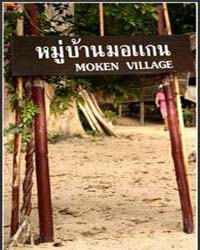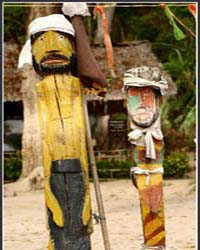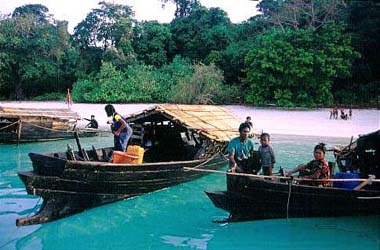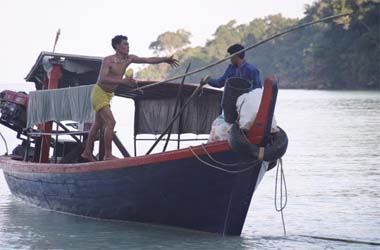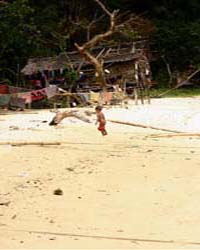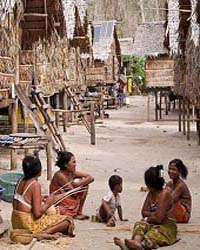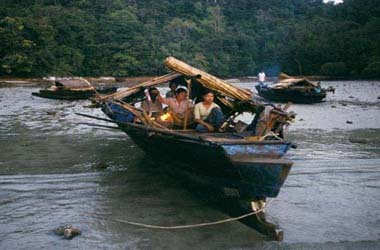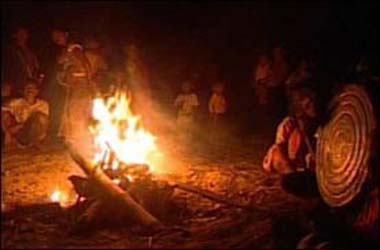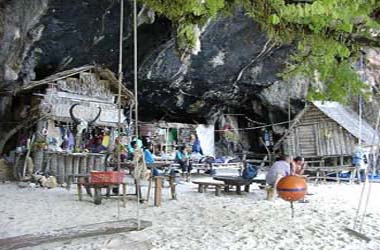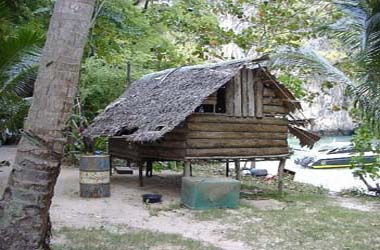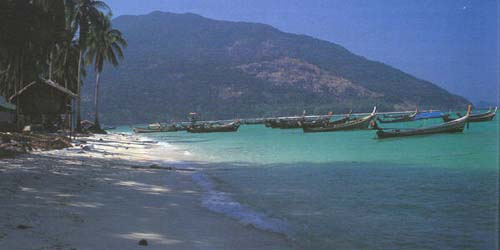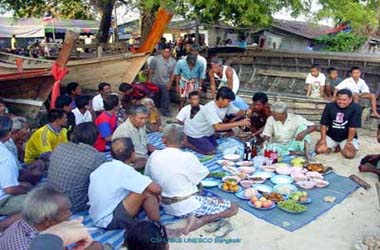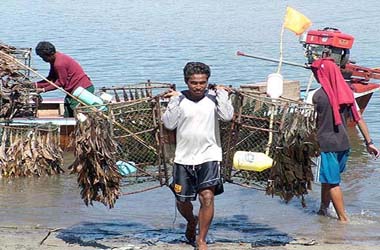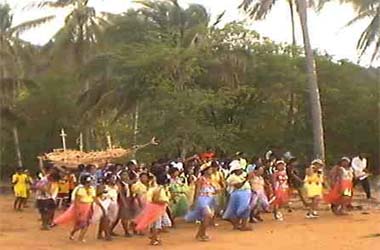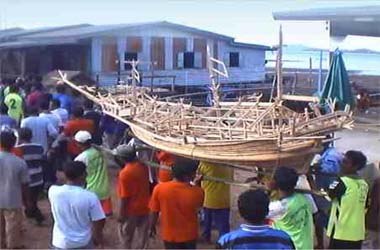![]()
SEA GYPSIES

In Thailand, there are three main groups of sea gypsies the Moken, the Moklen, and the Urak Lawoi. All of them are known to the Thais as "Chao Lay" (sea people), an umbrella term depicting indigenous sea tribes whose life is (or was) closely tied to the sea.
The Moken
|
|
|
Introduction
There is a group of about 2000 to 3000 people who live off the coast of Thailand, Myanmar and Malaysia around the Surin Islands (a national park). They are known as the Moken, sometimes referred to as Sea Gypsies because they are sea dwellers and spend a great deal of time on the sea. Their language appears unrelated to any other, and their real origin is unknown. Some experts believe they were the first inhabitants of these coastal regions, known as the Andaman. This nomadic sea culture most likely migrated from southern China some 4,000 years ago and, moving through Malaysia, eventually split off from other migrant groups in the late 17th century, however the exact history of their existence is not known.
Because of the Moken’s life on the sea, they have become excellent fisherman and extremely knowledgeable about the sea around them. If a man wants to have fish for breakfast, he goes out and catches a fish with a spear and it would take him no time at all. Studies done by Swedish scientist Anna Gislén have shown that they can see twice as well underwater compared to European peoples, however their vision outside of the water seems no different. Gislén learned the Moken underwater super-sight was created by constricting their pupils, which sharpens their focus. To discover if this was a learned or genetic behavior, Gislén has been training Swedish children to do the same. Within four to six months, they picked up the skill, and after their pupils automatically constricted whenever they touched water, giving rise to the skill is mostly learned. Brian Handwork from National Geographic reported that they can swim to depths as far as 75 feet down without any scuba gear or life support. They also have an amazing talent of lowering their heart rate, can stay underwater twice as long.
The main threat now to the culture is the Burmese coming from the mainland to fish and create a center of living for themselves. More recently, the Moken have been threatened by notices from the government that their land was going to be taken and they would have to leave immediately. This started happening right after coming home after the tsunami hit. The government offered them permanent housing on the mainland, but they refused and went back to their home to rebuild. According to Akom Samas, a leader of the tribe, he said, “A local government agency claimed our land -- they said they needed to build a hospital. We rejected this and started rebuilding. Certainly there are some greedy people trying to benefit from our misfortune. We've been intimated and threatened by private investors and by land speculators.” A settlement has been reached between the two, leaving over one third was taken for development. Currently the Moken have a 5 year lease on the land. The government recently gave them new fishing boats, however, because of the devastation, they remain idle and unused. Sea gypsies are not only struggling to maintain their sense of culture, but their very existence as well. Yet, they do not seemed to be entirely worried by all of this because ‘worry’ is not apart of their vocabulary.
It is
December 26, 2004. Several elders from the Moken tribe, a small community of
sea gypsies from the Surin islands Marine National Park off the coast of
Phang-Nga Province, Thailand, notice that the sea is churned up and moving
in an unusual way. They raise the alarm. Most of the inhabitants rush to
take refuge further inland. When they return, the village has been entirely
swept away by La Boon, as the Moken call the tsunami that devastated the
region.
Their boats and houses mounted on piles have been reduced to a heap of wood
and debris. But while Thailand mourns more than 5,000 victims, the Moken
community was spared. The elders’ knowledge of the sea saved their lives.
And ever since, their story has spread around the world.
The Moken are now rebuilding their village, using bamboo and leaves woven
together, in a non-traditional location inland, as dictated by the local
government authorities. They have settled in a forest, further from the sea,
and therefore a presumably safer but certainly not more advantageous site.
The new village is less sanitary and has poor ventilation and a cramped
design. Of most concern, the visibility of the Moken’s natural environment,
the sea, is substantially reduced.
The influence of the outside world is growing all the time. Since the
national park authorities forbade them from catching certain species such as
the sea cucumber and some shellfish that they used to sell, the Moken have
been deprived of one of their sources of income. A number of them have
already abandoned fishing to work as diving guides for tourists or garbage
collectors. The objective of UNESCO’s Coastal Regions and and Small Islands
programme is to call attention to their plight and help influence policy to
allow the Moken and other sea gypsy communities in Thailand to continue to
uphold their traditions and livelihoods, within the National Parks that
encompass their traditional homelands and waters.
|
|
|
Subsistence Strategy
They are hunter gatherers, and go from one island to the next in search of food. Their main food is fish, turtle, sharks and shells. (5) During low tide they collect sea cucumbers, and catch eels. At high tide, they dive for shellfish. Whatever they need is usually on or under the water. For a good nine months out of they year they are on boats on the sea searching for food. They learn how to swim before they can walk.
Sociopolitical System
There are various tribes of Moken, but all are welcoming of each other. The sociopolitical system could be a chiefdom, but more likely they are just tribes. When one Moken family member leaves to another community, they never say goodbye. Why is this? Well there is no word for ‘hello’ or ‘goodbye’ in the Moken language. Other words missing for the Moken language is ‘when’, they have no understanding of time, ‘want’ or ‘take’. If one sits on another man’s boat, and the owner was going to go out and fish, he would wait for the man to finish sitting because he has no sense of time, no really need to get anywhere in a hurry.
Gender Roles and Status
What is interesting is the word to harpoon a turtle is very close to the word when taking a woman. However, it must also be noted that the turtle is revered as one of the most sacred animals. It could be said that the Moken men see their woman as sacred as well. Everyone helps one another; no one thinks themselves higher than another. Everyone is equal. However, mostly the men are the ones who fish and the woman are the ones who cook.
Kinship Patterns
The thing about Moken kin is that everyone is regarded as family, because there is no word for ‘goodbye’ or ‘hello’ there is no need to regard one person as not apart of ones family. People come and go as they please, from one tribe to another. Each tribe is accepting and even with strangers, are peaceful and welcoming peoples.
|
|
|
Marital Customs and Living Arrangements
The Moken are known as Sea Gypsies or Men of the Sea because they live on the sea most of their lives in boats known as kabang. They are small and hand built, sea flotillas that hold everything. It is very important to them because it represents the human body; this is where they live and sleep and give birth. Boat is well organized. There are many children during these times, but their playground is the sea. The only form of swimming equipment they use is goggles. Originally they used to be made out of wood, but now they are made out of plastic since they trade with mainland Burma. On these boats, each holds one family, usually of three generations. Mostly what they catch is for themselves, but whatever else they do, they sell it to the markets. Their thatched roofs of the boats are often covered with fish, sea cucumbers, squid and other sea produce being dried for market.
During monsoon season, which is from June to October, each tribe heads back to their island build additional boats while occupying temporary huts. It is a complete change from living on the sea. They will have a ceremony to celebrate their life on land the first days they settle there again. It will last days, but the reason they do it is to become one with the spirits around them.
Religious Practices
They believe in animism, originally means the doctrine of spiritual beings. In hunter and gatherer societies, animism often means the human being is often equal with nature and not above it; respect for nature and everything around them is imperative. In such societies, ritual is vital for survival because it wins the favour of the spirits of one's source of food, shelter, and fertility and shunning evil spirits.
|
|
|
Interesting Anthropological Points
The Moken people still are extremely knowledgeable in the ways of the sea and because of their knowledge they survived the tsunami of December 26, 2004. There were even some who were at sea during the tsunami, and still survived. However, since the tsunami disaster of 2004, some refugee Sea Gypsy women and girls likely have ended up in prostitution in Thailand's thriving and notorious port brothels.
What is strange, in all the articles and information I found on the Moken culture, the one that completely a skewed the culture and who the people were was the New Yorker article written by Eliza Griswold. According to her there were only a couple hundred of these people left and that the people had no folklore of the wave whatsoever, but instead just saw the wave and ran. However, if this were so, it would not explain why their community survived and while the other cultures around them suffered great lost even though they ran.
Concluding Remarks
Lots of cultures are threatened around the world. Diversity is a struggle with the people of this world now; soon the world will become monotonous. The Moken are one of the last of the sea people to exist and it’ll be a great loss if they are lost
The Moklen
|
|
|
The Moklen
are a group of sea gypsies or "Chao Lay" which receive the least attention
from the media and public. This is because their villages are located in the
areas not frequented by tourists. So while their counterparts, the Urak
Lawoi and the Moken have been mentioned time and again because their homes
Phuket, Lanta, and Lipeh islands for the former and Surin islands for the
latter are popular tourist destinations, the Moklen are mentioned simply as
a subset of "Chao Lay" or "Thai Mai" ("new Thais" a Thai term refers to the
Urak Lawoi and the Moklen, most of whom have already adopted sendentary life
and acquired Thai citizenship). Moklen children receive a formal education
in the local schools where the instruction is conducted in standard Thai
language. Most of them no longer speak Moklen language but they still
understand it when their parents or their grandparents converse.
Most of the Moklen villages are found in Phang-nga Province on the west
coast of Thailand. They are scattered in the District of Khuraburi, Takuapa,
and Thaimuang.
Way of Life
Many of the Moklen have become land-based people. In fact, several Moklen
villages are located inland, not in coastal areas. Oftentimes they identify
themselves as traditionally land people who have never pursued maritime
nomadic life or lived in "kabang" boat like the Moken.
Nowadays, the Moklen engage in land-based occupation such as working in a
rubber or coconut plantation and being hired as laborers for miscellaneous
tasks. Those who live in coastal villages usually pursue marine activities
such as net-fishing or diving for marketable sea produce.
Although many Moklen adopted Buddhism as their religion and some even
entered Buddhist monkhood for a Lenten period, they still maintain their
animistic beliefs. The traditional Moklen annual celebration is in
February-March when they make offerings to their lengendary leader named Pho
Ta Sam Phan.
The Urak Lawoi
|
|
The Urak Lawoi
Chao Lay (or Sea People) are a group of people living in southern Thailand around the islands and coastal areas of the Andaman Sea. Their villages can be found in Phang-nga, Phuket, Krabi and Satun. The Urak Lawoi have their own language and traditions. Because of their small numbers and dispersed settlements, the Urak Lawoi often escape the attention of outsiders especially the Thai authority (Pratuang Krauhong, 1998: 2).
The Urak Lawoi are generally called Chao Lay, Cho Nam, and Thai Mai (New Thai). However, they do not want to be called Chao Nam, because it is a derogatory term as they consider Nam to imply semen (Chantas Thongchuay, 1985). Nowadays, the Urak Lawoi prefered to be called Thai Mai which connotes that they are an integral part of the Thai state.
The Legend of the Urak Lawoi
David Hogan (1972: 128-129) recorded a legend told by a 60-70 year-old Urak Lawoi on the Adang island that long time ago, God sent Nabeeno to persuaded Urak Lawoi ancestors to give reverence to God. The Urak Lawoi ancestors refused to do so, and God gave them a curse so they moved to Gunung Jerai. Some Urak Lawoi went into the forest and became wildmen, monkeys, and squirrels, some became sea nomads and lived on boats called Jukok. Gunung Jerai remains a sacred place for the Urak Lawoi as they believed that their ancestors used to settle there. The Urak Lawoi organize a boat ceremony twice a year, and toward the end of the ceremony, a model boat is sailed away believing to head for this previous settlement around Gunung Jerai area.
The Urak Lawoi in Sangka-u Village, Lanta island, Krabi province
There are 81 households, 93 families, 358 people in the village of Sangka-u on Lanta islands. There is also an elementary school and a joss house for worship. The people believe that worshopping the joss house can protect them from harm. There is one public house for community activities such as making a model boat for boat-floating ceremony, etc.
Most people in the village are relatives . The bamboo-houses with galvanized iron or tiles roof are located very close to one another and there are no fences. The size of the house is around 3x4 meters. When the members of family increase, they will lengthen the house outward in the direction of the sea.
Inland houses are built on small hills, but the front of the houses is seaward. These houses are built on 1-meter pillars. Ducks and chicken are raised under the houses. Most of these houses have balcony which serves as a living room for different activities, ranging from repairing fish-net to chatting with neighbors.
Inside the house
The Urak Lawoi houses have wide space for resting, eating, and watching television. The bedroom zone is separated by curtain or closet. Many households have electrical equipment such as televisions, radios and fasn. Ten families in the village have the refrigerators and 53 families (from 81 families) have television. The Urak Lawoi in Sangka-u use charcoal or gas stove for cooking.
Building a House
Normally the Urak Lawoi build their house through cooperative labor. There are 2-3 heading people with support from the relatives and neighbors. The house owner pays back the helpers by providing them lunch. In terms of house materials, poor families use bamboo and galvanized iron roof while rich families use cement and tiles roof.
|
|
|
Social, Economic and Cultural Aspects
The daily lives of the Urak Lawoi are simple. In the morning, the men go out fishing while the women do the housework and wait for their husband to come back around noon. Fish catch is both for family’s meals and for selling to the Tao Kae (the entrepreneurs).
In the afternoon, Urak Lawoi women rest while the men fix fishing tools. Kids usually play around the community. Teenagers often go to their friends’ houses, chatting or listening to the radio. Urak Lawoi subsistence lifestyle is now changing. Most of them now need to work for wages to get more money. Therefore, in the daytime, only the elders and kids stay home. The rest go out for work.
Food
Besides seafood, rice is the main staple for the Urak Lawoi. Normally, they eat rice with several dishes like Southern Thai food. Coconut is the crucial ingredient for making various dishes and desserts. For vegetables, they eat local vegetables or buy some from grocery stores in the community.
The Urak Lawoi usually eat whenever they are hungry, so there is no set meal at a certain time. Normally, they have 2 meals per day, in the morning and evening. Factory-made snacks and instant noodle become a popular food after the integration to commercial economy.
Education
Aporn Ukrit (1992) studied about Chao Lay education and stated that the infants and children are raised by the adults until 5-6 years old. Then, the boys can join their father’s trip to the sea while the girls help their mother doing housework. When they become teenagers, they will get married and make their own families.
In the past, the Urak Lawoi parents spoke Urak Lawoi language to their kids. Presently, they use both traditional language and Thai language in order to prepare the kids to get into Thai school which use Thai as main language. It is quite easy for the kids to learn Thai because they watch Thai television.
Medical Care
In the earlier days, the Urak Lawoi believed that the cause of sickness came from spirits. They had local doctor (To Maw) who cured the sickness by incantation or using holy water.
To Maw is the spirit medium, communicating between the Urak Lawoi and the spirits. To Maw are chosen by the elderly traditional To Mo to learn about spiritual curing.
At present, the Urak Lawoi often go to the hospital when they are sick. Sometimes they buy drugs from grocery stores. If they do not get better, they will go to the hospital.
Occupation
Normally, people earn their livelihood by traditional fisheries. In the past, the Urak Lawoi caught the fish by simple tools for household consumption. At present, they need to adopt market economy in order to survive. There are 57 households which have motor boats. Many Urak Lawoi prefer working for a Tho Kae to being independent fishers because of convenience and security-related reasons. Working for a Tho Kae means reducing the responsibility of obtaining and maintaining the boats and fishing supplies.
Allso, the Urak Lawoi grow coconuts, cashew nuts and some local vegetables on the hill for selling and consuming in the households. When tourism industry comes, some people go to work as unskilled labors to gain wage. From statistics, the average amount of money they earn per year is 36,000 baht.
|
|
|
Ceremonies
There are 2 important ceremonies in the community:
-
Paying respect and giving offerings to the female guardian of the boat. It is believed that doing so will prevent the boat crew from dangers at sea.
-
Loi rua (floating boat) the most important festival that they celebrate which takes place for 3 days and 3 nights during the full moon of the 6th and 11th months of the lunar calendar. The Urak Lawoi use the occasion to pay respect to their ancestors and symbolically to float away their misfortune with a small ceremonial boat, constructed mainly out of the soft wood of the zalacca palm for this special purpose.
The Changing Society
The way of life of the Urak Lawoi gradually integrates into Thai culture. Their sufficient economy has turned to market economy which makes them dependent on outsiders. They need more money to satisfy themselves materially. By this reason, the people try to work harder; however, the wage is still inadequate for the expenditure.
